The landscape of smoking has undergone a significant transformation over the past few decades. Traditional cigarettes, once the predominant method of nicotine consumption, are gradually being replaced by safer alternatives such as vaping. This article delves into the differences between smoking classic cigarettes and using vapes, examining their processes, compositions, and the overall impact on health.
What is a Cigarette?
A cigarette is a small cylinder of finely cut tobacco leaves rolled in thin paper for smoking. It typically contains a mixture of tobacco, chemical additives, and a filter designed to reduce the harshness of the smoke. When a cigarette is lit, the tobacco undergoes combustion, producing smoke that is inhaled into the lungs.
The Process of Smoking a Classic Cigarette
1. Ignition: The smoker lights the cigarette, initiating the combustion of tobacco.
2. Inhalation: The smoker inhales the smoke, drawing it through the filter and into their lungs.
3. Nicotine Absorption: Nicotine, along with other chemicals, is absorbed into the bloodstream through the lungs.
4. Exhalation: The smoker exhales the smoke, releasing it into the surrounding environment.
What is a Vape?
A vape, or electronic cigarette, is a device that heats a liquid (known as e-liquid or vape juice) to create vapor, which the user inhales. Vapes typically consist of a battery, a heating element (coil), and a tank or cartridge that holds the e-liquid. The e-liquid usually contains a combination of propylene glycol (PG), vegetable glycerin (VG), flavorings, and often nicotine.

The Process of Vaping
- Activation: The user activates the device, usually by pressing a button or inhaling, which heats the coil.
- Vaporization: The e-liquid is heated, converting it into vapor.
- Inhalation: The user inhales the vapor into their lungs.
- Nicotine Absorption: If the e-liquid contains nicotine, it is absorbed into the bloodstream through the lungs.
- Exhalation: The user exhales the vapor, which dissipates more quickly than smoke.
Key Differences in the Smoking Process
The primary difference between smoking classic cigarettes and using vapes is the absence of combustion in vaping. This fundamental distinction results in a significantly different experience and impact on health.
Combustion vs. Vaporization
Classic Cigarettes
Involve combustion of tobacco, producing smoke. Smoke contains a variety of harmful substances, including:
- Carbon monoxide
- Tar
- Formaldehyde
- Benzene
- Polycyclic aromatic hydrocarbons (PAHs)
- Heavy metals
- Other carcinogens and toxins
Vapes
- Utilize vaporization, eliminating combustion.
- Vapor typically contains fewer harmful substances:
- Propylene glycol (PG) and vegetable glycerin (VG) as thickeners
- Flavorings
- Nicotine (optional)
- Fewer carcinogenic and toxic substances compared to tobacco smoke
Composition of Inhaled Substances
Tobacco Smoke
Contains thousands of chemicals, many of which are harmful to the respiratory system.
Key harmful substances include:
- Carbon monoxide: A colorless, odorless gas that can impair oxygen delivery in the body.
- Phenols: Toxic compounds that can damage lung tissue.
- Formaldehyde: A known carcinogen.
- Tar: Contains numerous carcinogens that can lead to respiratory diseases and cancer.

Vapor
- Composed primarily of PG and VG, which are generally recognized as safe (GRAS) by regulatory authorities when used in food and pharmaceuticals.
- Flavorings: Used to provide various tastes, some of which may pose health risks when inhaled.
- Nicotine: Present in varying concentrations, similar to traditional cigarettes, but can also be absent in nicotine-free e-liquids.
- Toxic Substances: Some compounds in vape liquids can form toxic substances when heated, such as formaldehyde and acrolein, though typically at lower levels than in cigarette smoke.
Nicotine Delivery
Classic Cigarettes
- Nicotine is delivered through the inhalation of smoke, which carries ash and other combustion by-products.
- Absorption is rapid, leading to a quick onset of effects.
Vapes
- Nicotine is delivered through the inhalation of vapor.
- The method of absorption is similar, but the absence of combustion by-products can make it less harmful.
- Nicotine concentration can be tailored, allowing for gradual reduction and potential cessation.
Health Impacts of Cigarettes vs. Vapes
Cigarettes
- Respiratory Issues: Smoking is linked to chronic obstructive pulmonary disease (COPD), chronic bronchitis, emphysema, and lung cancer.
- Cardiovascular Diseases: Increases the risk of heart disease, stroke, and hypertension.
- Cancer: Associated with various cancers, including lung, throat, mouth, esophagus, and bladder.
- Pregnancy Complications: Can lead to premature birth, low birth weight, and developmental issues in infants.
Vapes
- Respiratory Effects: While generally less harmful, vaping can still cause respiratory irritation and is linked to conditions such as “popcorn lung” (bronchiolitis obliterans) in severe cases.
- Cardiovascular Impact: Studies suggest that vaping may pose fewer cardiovascular risks than smoking, but long-term effects are still being researched.
- Cancer Risk: Lower exposure to carcinogens compared to smoking, but not entirely risk-free due to potential toxicants in some e-liquids.
- Youth and Non-Smokers: Concerns about the appeal of vaping to non-smokers, especially youth, potentially leading to nicotine addiction.
Advantages of Vaping Over Cigarettes
- Reduced Harm: Vaping eliminates the combustion process, significantly reducing the intake of harmful substances found in cigarette smoke.
- Customizable Nicotine Levels: Users can choose e-liquids with varying nicotine strengths, including nicotine-free options, aiding in smoking cessation efforts.
- Less Secondhand Smoke: Vapor dissipates more quickly than smoke and contains fewer harmful chemicals, reducing the risk to bystanders.
- Odor Reduction: Vapor tends to have a less persistent and more pleasant odor compared to cigarette smoke.
- Cost-Effective: Although the initial investment in a vape device can be higher, the ongoing cost of e-liquids is generally lower than purchasing cigarettes.
- Variety of Flavors: E-liquids come in a wide range of flavors, offering a more enjoyable experience for users.
- No Ash or Residue: Vaping produces no ash, reducing the mess and fire hazard associated with smoking.
- Potential for Smoking Cessation: Vaping can serve as a transitional tool for smokers looking to quit, allowing for a gradual reduction in nicotine intake.
- Less Environmental Impact: Vaping generates less litter compared to cigarette butts, which are a significant source of environmental pollution.
- Controlled Dosing: Vapers can control the amount of vapor they inhale, providing a more consistent and manageable nicotine intake.
Regulatory and Social Considerations
Regulations
- Many countries have implemented regulations to control the sale, advertising, and use of e-cigarettes, particularly among minors.
- Standards for e-liquid ingredients and device safety are being developed to ensure consumer safety.
Social Perceptions
- Vaping is often perceived as a safer alternative to smoking, though public opinion is divided.
- Anti-vaping campaigns highlight potential risks, particularly to youth and non-smokers.
Future of Smoking and Vaping
As research continues, the understanding of the long-term effects of vaping will evolve. Technological advancements in vape devices and e-liquid formulations aim to reduce health risks further. Public health initiatives and regulations will likely continue to adapt, balancing the promotion of harm reduction for smokers with the prevention of new nicotine addiction cases.
Conclusion
The shift from traditional cigarettes to vaping represents a significant advancement in harm reduction for nicotine users. While both methods deliver nicotine, the absence of combustion in vaping results in fewer harmful substances being inhaled. Vaping offers customizable nicotine levels, reduced secondhand smoke exposure, and a variety of flavors, making it an appealing alternative for many smokers. However, it is essential to acknowledge that vaping is not entirely risk-free, and users should remain informed about the potential health impacts. As research continues to evolve, the understanding of vaping and its long-term effects will become clearer, guiding public health policies and individual choices.

I am an accomplished coder and programmer, and I enjoy using my skills to contribute to the exciting technological advances that happen every day.
